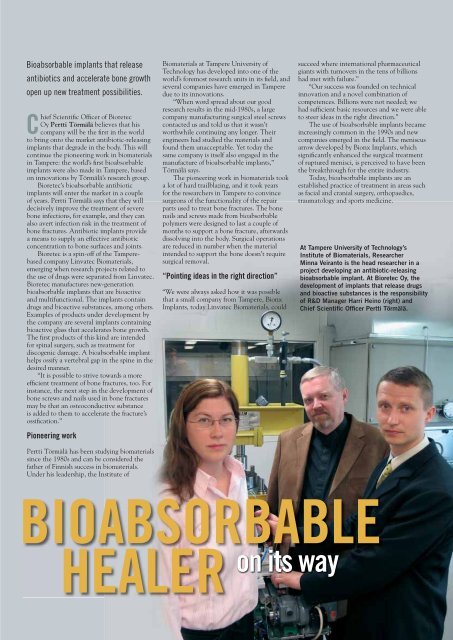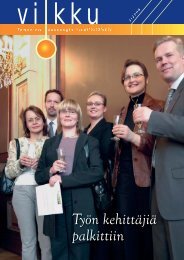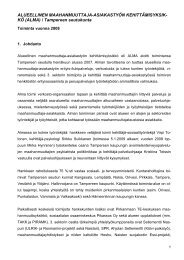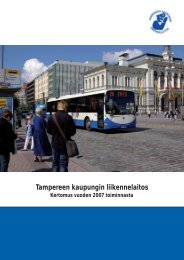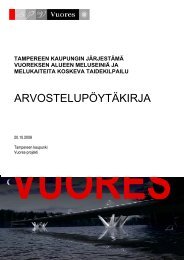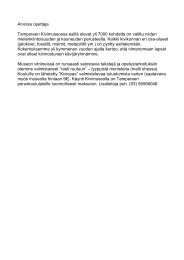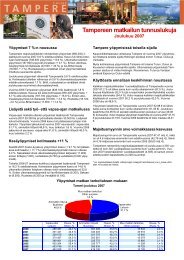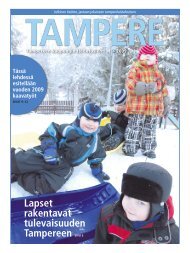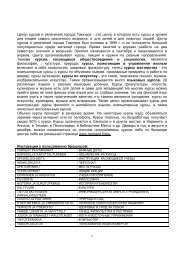- Tampere seizes creative economy
- Tampere seizes creative economy
- Tampere seizes creative economy
Create successful ePaper yourself
Turn your PDF publications into a flip-book with our unique Google optimized e-Paper software.
Bioabsorbable implants that release<br />
antibiotics and accelerate bone growth<br />
open up new treatment possibilities.<br />
Chief Scientifi c Offi cer of Bioretec<br />
Oy Pertti Törmälä believes that his<br />
company will be the fi rst in the world<br />
to bring onto the market antibiotic-releasing<br />
implants that degrade in the body. This will<br />
continue the pioneering work in biomaterials<br />
in <strong>Tampere</strong>: the world’s fi rst bioabsorbable<br />
implants were also made in <strong>Tampere</strong>, based<br />
on innovations by Törmälä’s research group.<br />
Bioretec’s bioabsorbable antibiotic<br />
implants will enter the market in a couple<br />
of years. Pertti Törmälä says that they will<br />
decisively improve the treatment of severe<br />
bone infections, for example, and they can<br />
also avert infection risk in the treatment of<br />
bone fractures. Antibiotic implants provide<br />
a means to supply an effective antibiotic<br />
concentration to bone surfaces and joints.<br />
Bioretec is a spin-off of the <strong>Tampere</strong>based<br />
company Linvatec Biomaterials,<br />
emerging when research projects related to<br />
the use of drugs were separated from Linvatec.<br />
Bioretec manufactures new-generation<br />
bioabsorbable implants that are bioactive<br />
and multifunctional. The implants contain<br />
drugs and bioactive substances, among others.<br />
Examples of products under development by<br />
the company are several implants containing<br />
bioactive glass that accelerates bone growth.<br />
The fi rst products of this kind are intended<br />
for spinal surgery, such as treatment for<br />
discogenic damage. A bioabsorbable implant<br />
helps ossify a vertebral gap in the spine in the<br />
desired manner.<br />
“It is possible to strive towards a more<br />
effi cient treatment of bone fractures, too. For<br />
instance, the next step in the development of<br />
bone screws and nails used in bone fractures<br />
may be that an osteoconductive substance<br />
is added to them to accelerate the fracture’s<br />
ossifi cation.”<br />
Pioneering work<br />
Pertti Törmälä has been studying biomaterials<br />
since the 1980s and can be considered the<br />
father of Finnish success in biomaterials.<br />
Under his leadership, the Institute of<br />
Biomaterials at <strong>Tampere</strong> University of<br />
Technology has developed into one of the<br />
world’s foremost research units in its fi eld, and<br />
several companies have emerged in <strong>Tampere</strong><br />
due to its innovations.<br />
“When word spread about our good<br />
research results in the mid-1980s, a large<br />
company manufacturing surgical steel screws<br />
contacted us and told us that it wasn’t<br />
worthwhile continuing any longer. Their<br />
engineers had studied the materials and<br />
found them unacceptable. Yet today the<br />
same company is itself also engaged in the<br />
manufacture of bioabsorbable implants,”<br />
Törmälä says.<br />
The pioneering work in biomaterials took<br />
a lot of hard trailblazing, and it took years<br />
for the researchers in <strong>Tampere</strong> to convince<br />
surgeons of the functionality of the repair<br />
parts used to treat bone fractures. The bone<br />
nails and screws made from bioabsorbable<br />
polymers were designed to last a couple of<br />
months to support a bone fracture, afterwards<br />
dissolving into the body. Surgical operations<br />
are reduced in number when the material<br />
intended to support the bone doesn’t require<br />
surgical removal.<br />
“Pointing ideas in the right direction”<br />
“We were always asked how it was possible<br />
that a small company from <strong>Tampere</strong>, Bionx<br />
Implants, today Linvatec Biomaterials, could<br />
succeed where international pharmaceutical<br />
giants with turnovers in the tens of billions<br />
had met with failure.”<br />
“Our success was founded on technical<br />
innovation and a novel combination of<br />
competences. Billions were not needed; we<br />
had suffi cient basic resources and we were able<br />
to steer ideas in the right direction.”<br />
The use of bioabsorbable implants became<br />
increasingly common in the 1990s and new<br />
companies emerged in the fi eld. The meniscus<br />
arrow developed by Bionx Implants, which<br />
signifi cantly enhanced the surgical treatment<br />
of ruptured menisci, is perceived to have been<br />
the breakthrough for the entire industry.<br />
Today, bioabsorbable implants are an<br />
established practice of treatment in areas such<br />
as facial and cranial surgery, orthopaedics,<br />
traumatology and sports medicine.<br />
At <strong>Tampere</strong> University of Technology’s<br />
Institute of Biomaterials, Researcher<br />
Minna Veiranto is the head researcher in a<br />
project developing an antibiotic-releasing<br />
bioabsorbable implant. At Bioretec Oy, the<br />
development of implants that release drugs<br />
and bioactive substances is the responsibility<br />
of R&D Manager Harri Heino (right) and<br />
Chief Scientific Officer Pertti Törmälä.<br />
BIOABSORBABLE<br />
HEALER<br />
on its way<br />
<strong>Tampere</strong> Business • Science • Life 21


